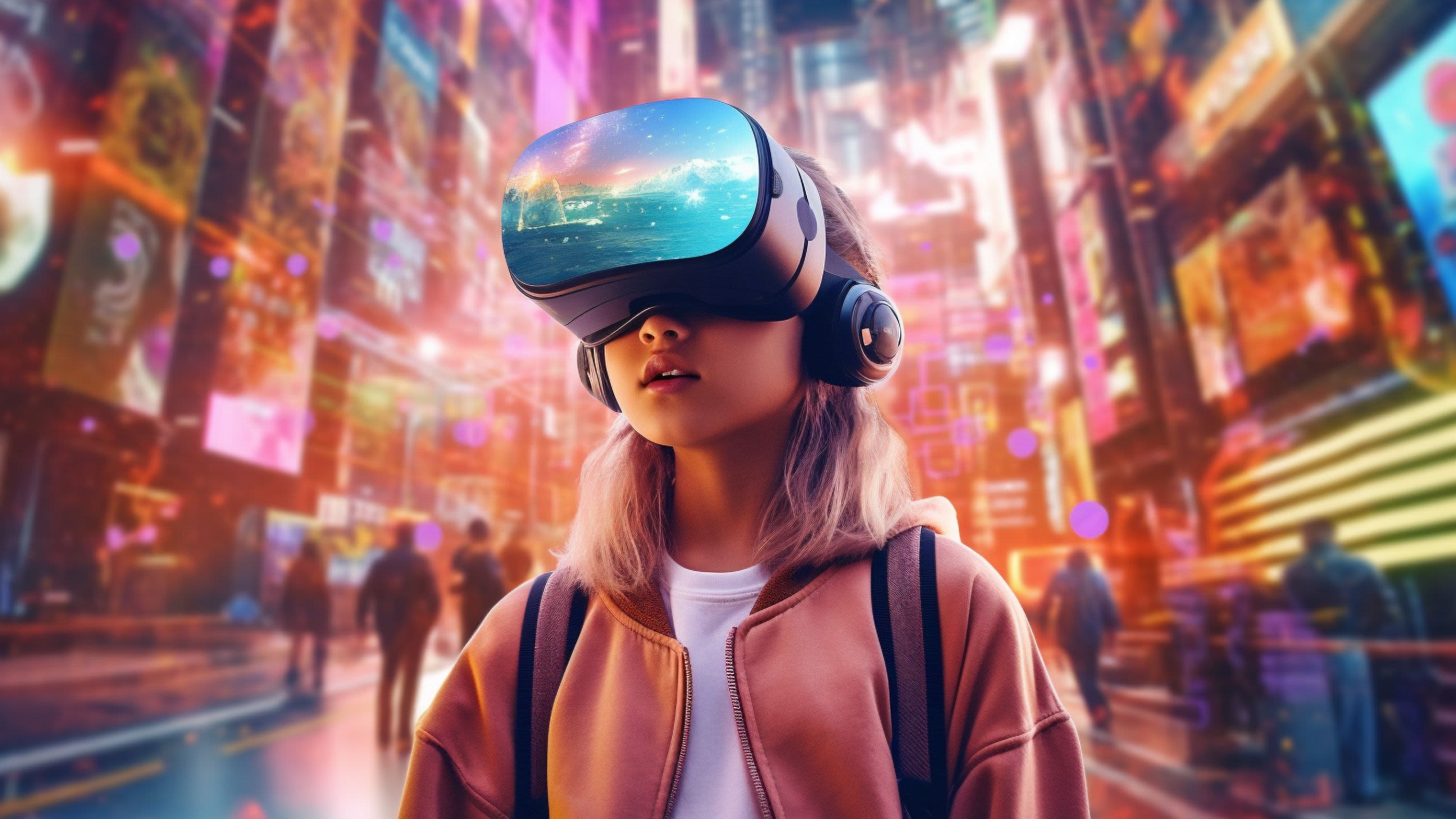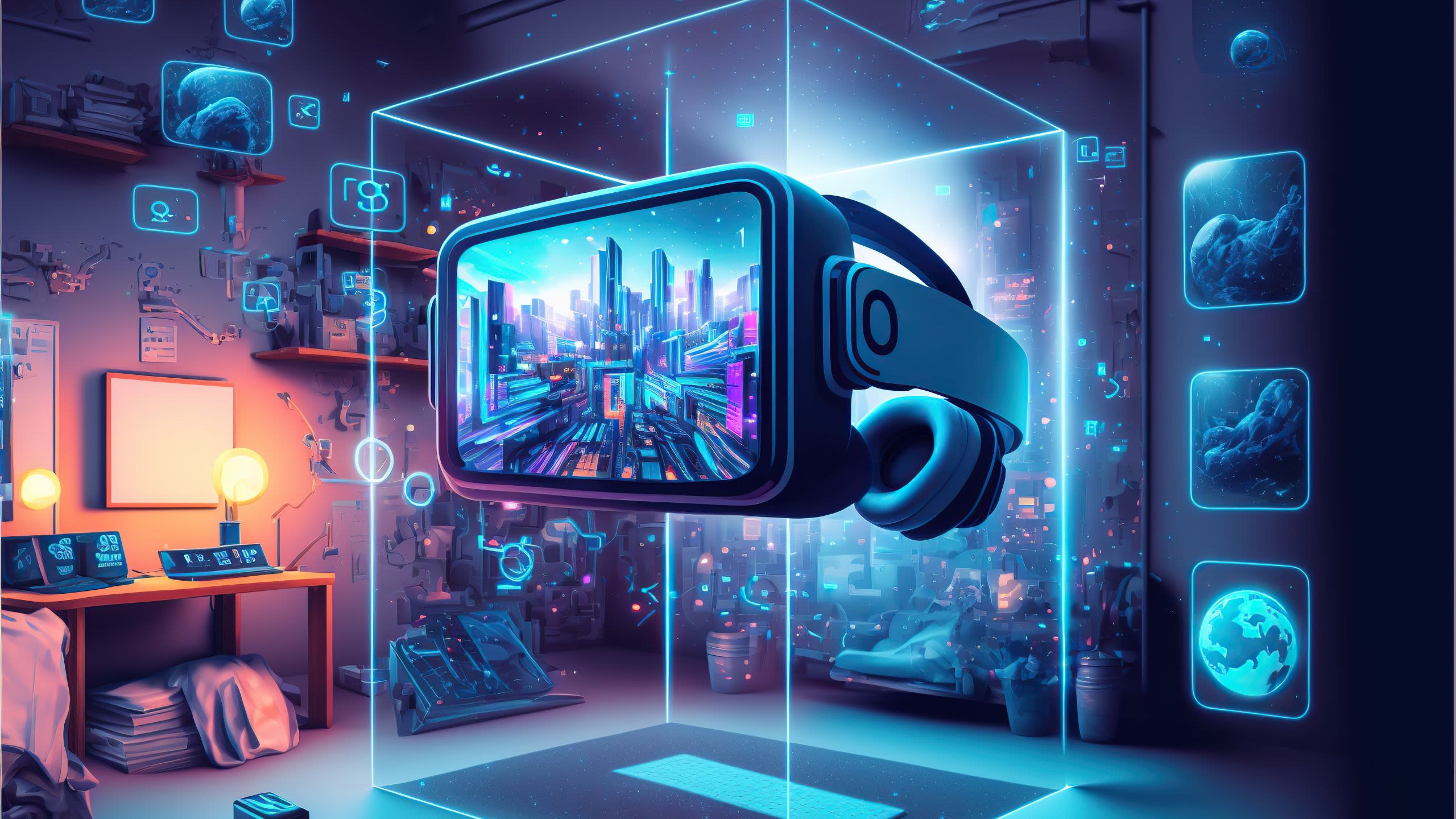Could the metaverse bring us closer to a sustainable reality?

The Big Question
The year is 2050. You sip your morning coffee while gazing out over the forest. The crickets are chirping, dew drops sparkle on the tips of the pine needles, and you tune in to the sound of a trickling stream nearby. But alas, it’s time to go to work.
The trees fade away before your eyes, replaced by your work calendar. Lots of meetings today. You open your interactive wardrobe and swipe through outfit combinations. They’ve been curated by your virtual stylist subscription – what a game-changer! You select something professional and settle in for the day.
Are you dreaming? Nope – you’re in the metaverse. You spend your day living, working, shopping, learning, and interacting, in the virtual world. You’re probably doing it all from the comfort of your couch in your favourite pyjamas. But what is happening outside? Could you really visit that forest if you wanted to? It’s 2050 after all… did we reach net zero?
With the boom of technology like the metaverse, artificial intelligence (AI), and virtual reality (VR), Contact wanted to know what impact these technologies could have on the world’s sustainability goals.
Will the replacement of tangible things for virtual alternatives help reduce the global waste problem? Could digital experiences allow society to overcome the behavioural barriers to addressing climate change? Or will this infrastructure and its energy consumption exacerbate the issues?
Contact put the question to UQ researchers: could technology like the metaverse and AI, bring us closer to a sustainable reality?


Dr Jennifer Yarnold
Research Fellow, Centre for Policy Futures
Faculty of Humanities and Social Sciences
“Imagine no possessions.” I doubt John Lennon had virtual reality in mind when he penned his famous lyric, but certainly I believe that the metaverse and AI could create more sustainable futures.
First, and most obvious, would be a future based on the substitution from tangible to virtual things. This would reduce the damage to ecosystems, pollution and waste created from extracting resources and making goods, and their disposal at end of life. For example, if we are spending our time in the metaverse, do we stop purchasing so many real 'fast-fashion’ products?
Second, would be through greater efficiency. Already AI is being integrated into energy, food and production systems to better predict and distribute goods and energy from where they are produced to where they are needed – reducing the redundancies of human-based systems.
And third, in an oddly paradoxical way, could be that through the metaverse we find ways to better connect in with, appreciate and even regenerate natural systems. For instance, there is growing demand for carbon, biodiversity and nature-based offsets.
What if fund managers, sustainability managers and regular people like you and I could choose precisely where in the world and what type of offset we wanted to purchase – say, the planting of a tree in Borneo, a mangrove in Fiji, or a coral transplanted to restore part of the Great Barrier Reef?
Perhaps in the metaverse or with AI, we could visualise where our tree, mangrove or coral is planted, monitor it as it grows, see how it’s improving the surrounding ecosystem and biodiversity, and gain real-time information on how much carbon has been captured or how the water quality has improved. That would be pretty cool.
Like all technologies, though, the future will depend on how and for what humans prioritise to use it. Unless, that is, AI evolves – like humans – where the main objective is survival, but – unlike humans – realises the necessity to sustain the planet which enables that survival.


Dr Rocky Tong Chen
Lecturer, ARC DECRA Fellow with UQ Data Science
School of Information Technology and Electrical Engineering
Given my background in lightweight machine learning, I would like to share my thoughts from the resource consumption perspective.
Amid the huge innovations we are witnessing, the environmental pressure from the development and maintenance of modern AI technologies is far beyond our imagination. For example, the Transformer algorithm, the backbone of the famous ChatGPT, produces over 270 tonnes of CO2 when being trained to understand human language.
In my view, researchers are going through a 3-stage process towards a sustainable future with AI. Being a car enthusiast, please indulge me in my use of vehicle analogies.
1. Passive sustainability
Most AI technologies and algorithms were originally centred around performance, like car engines were once benchmarked solely by their power outputs.
As awareness of sustainability rises, passive clean technologies like emission filters and start-stop functions are being retrofitted to cars without dramatically changing their fuel-burning nature.
Similarly, there have been many add-ons you can apply to a sophisticated AI algorithm, such as low-precision computing, to generate a computationally simpler, and hence cleaner, version of it.
2. Active sustainability
Instead of passively patching up the technology, it makes more sense to consider the development of efficient, green, yet high-performance cars from scratch, which is why we are seeing more hybrid or fully electric vehicles nowadays.
Analogously, one AI example is the lightweight AlphaGo Zero. With the help of the reinforcement learning algorithm, it outperforms its ancestor AlphaGo, while bringing over 20 times reduction in energy consumption.
AI that comes with sustainability by design can bypass the undesirable performance-efficiency trade-off, and is naturally more scalable.
3. Ubiquitous sustainability
In the long-term vision, we expect AI to be not only sustainable itself, but also a key driver for broader sustainability and low-emission goals.
Simply put, AI systems are a promising decision-support tool that can help us to optimise carbon footprints in various domains, including road planning, advanced manufacturing, renewable energy production and so on.
While we may already see some of those applications, there are more exciting breakthroughs to expect in this generative AI era.


Associate Professor Stephen Viller
Leader, Human-Centred Computing discipline
School of Information Technology and Electrical Engineering
It’s an often-stated fact that the computational power in our smartphones, which we increasingly depend upon to navigate the digital world, is millions of times more powerful than the Apollo 11 guidance computer that navigated to the moon.
The exponential growth of digital technologies since the 1960s has enabled mixed reality technologies that underly the metaverse concept, and generative AI models such as ChatGPT, to move out from research labs and into our everyday lives. They bring with them a host of opportunities for improving the way we work, socialise, and entertain ourselves, but also threats to society and the environment if we don’t consider their potential negative impact.
The carbon footprint of digital infrastructure, such as the data centres that deliver the ‘in the cloud’ data storage, and processing required by these technologies is now on a scale that exceeds the airline industry. Large players like Google, Amazon, and Meta are able to transition their data centres to carbon-neutral operation, but this is not necessarily the case for smaller providers.
On the flipside of this equation, digital technologies promise a way for us to reduce our carbon footprint associated with travel by providing online platforms for meeting. The metaverse is currently interpreted as a utopian but low-fidelity way to meet online, which might be ‘better than being there’, but it has a long way to go before it delivers on this promise. The COVID-19 pandemic did a lot to shift our thinking about the values of in-person versus online collaboration.
The decision to meet via platforms like Zoom or Teams – rather than flying to meet in-person – is no longer interpreted as a lack of commitment to the meeting, but as lockdowns and travel restrictions lifted we quickly returned to old work habits for meeting and interaction. The threat of climate crisis was driving researchers to find more engaging ways to meet online before COVID-19 made it a necessity.
This work has some way to go before putting on your smart glasses to meet in the metaverse will be as ubiquitous as our current use of social media.
If the computational power of digital technology is something we can take for granted, then it is the experiences we build on top of it that matter. These experiences will arise from the creative and human-centred design of technology, that we apply to problems in the world.
If we shift our focus from what the technology is capable of, to how we can harness the technology for a positive impact on people’s lives, these technologies can deliver a more sustainable future.


Dr Greg Winslett
Deputy Director, Digital Learning
Institute for Teaching and Learning Innovation
The way we leverage digital technology in our education system is critical to supporting our progress towards a sustainable future.
Educational technology (ed-tech) enthusiasts are looking at topics like access, ethics and sustainability, and the role digital technology plays in these spaces. While emerging technology such as AI, virtual labs, simulations, and maybe even the metaverse, can have incredible applications for learning and research, we recognise that digital teaching technologies and practices can reproduce, and even amplify, some social problems.
This indicates that we need a systematic and evidence-based approach to the types of technologies and practices we adopt, the partners we engage with, and the experiences we provide for students and teachers.
With regards to sustainability, the most visible dilemma is that with 'more access' to education, we risk more carbon emissions. Recent research indicates that enterprise technology is responsible for 1% of total greenhouse gas emissions. That's half of the emissions from aviation, with communication and media service technologies at the top of the list.
Notably, these emissions are mostly from end-user devices – laptops, tablets, phones and desktop computers.
We need to do more to control and reduce device proliferation, leverage cleaner energy sources for these devices, and repair, reuse and recycle.
Although strategies are merging to help minimise 'the carbon in the cloud', this will not be enough. The benefits of new technologies and practice need to be tightly coupled with the initiatives to support a sustainable future.
This means producing digital teaching and learning eco-systems and experiences that provide parity of outcomes for on-campus students and reduce the need for costly travel. Flexible scheduling and open education resources can help. Adaptive learning technologies, generative AI and the virtual labs and simulations promised by the metaverse can also reduce the need to travel, possibly allowing greater equity in education despite geographical barriers.
Furthermore, we need to resist the temptation to neatly categorise this work into the 'sustainability' box.
Committing to broadening access, means committing to looking anew at underserved communities and to consider – in addition to climate change – how we can achieve equitable social access to education more broadly, through digital technology.
